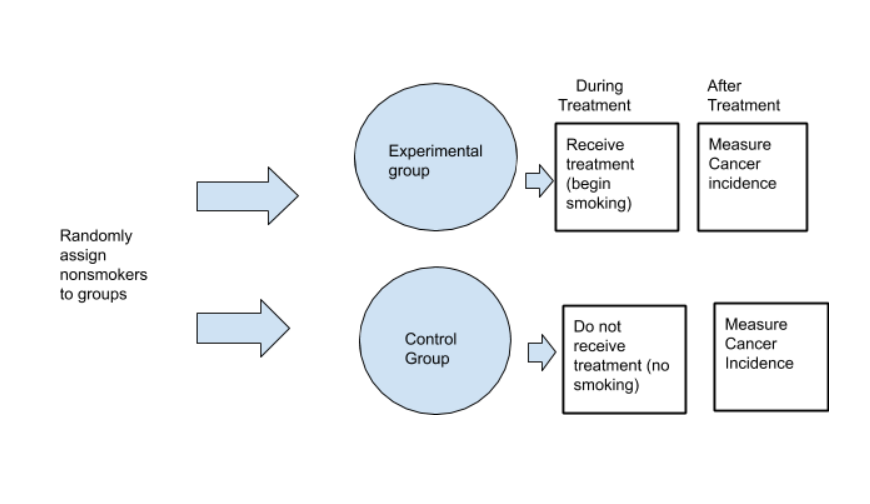Experimental research is one of the research methodologies adopted by PhD students. This is a type of scientific research. It involves using two sets of variables. One set of variables are kept constant whereas the other set of variables are studied as the subject of experiment.
The significance of using this research method is it aids in conducting experiments and collecting large amounts of data.
Characteristics of experimental research
- Subjects are randomly assigned to their experimental conditions.
- A researcher is able to modify an independent predictor variable.
- Subjects are treated similarly in regard to all variables involving different experimental conditions. This doesn’t apply to independent variables.
‘Cause and effect’ phenomenon
An experimental research is expected to establish an ‘cause and effect’ approach. The cause is the deciding factor based on which the effects are observed in an experiment. This is done to avoid any confusion that could arise because of naturally occurring events. Such events could make it hard to draw conclusions.
Hence, experimental research is carried in the following situations:
- The cause and effect phenomenon requires time as a vital factor. This factor establishes a relatIonship between the cause and the effect.
- There is an invariable behaviour between cause and effect.
- Desirability is the deciding distinct factor in the cause and effect relationship.
Types of experimental research
The experimental research designs are categorised into three types based on how the subjects are classified by the researcher. The basis of this organisation is done in accordance with various groups and conditions. The different types of this research design are:
1. Pre – experimental research design
This is the simplest of all the experimental research designs.Initially factors associated with the cause and effect of a phenomenon are considered. Based on them, a single group or groups in numbers are kept under observation for study.
This type of research design is further classified into three types:
- One shot case study research design
- One group Pretest-posttest research design
- Static group comparison
2. True – experimental research design
This is the most accurate design among the three experimental research designs. Here, statistical analysis is used to prove or disprove hypothesis. This experimental research method is generally executed in experiments related to physical sciences.
The significance of this design is that, this is the only research design that establishes a cause and effect relationship within a group or groups. A designs hould satisfy following factors to be recognised as a true-experimental research design.
They are:
- Control group and experimental group
- A control group involves participants who are familiar with the experimental group but the rules of experimental group doesn’t apply to them.
- Whereas, in the experimental group the participants have applied experimental research rules.
- Researcher control variables
- Random distribution
3. Quasi – experimental research design
As the name suggests, the quasi experimental design is a seemingly experimental design. The difference between an actual experimental research and a quasi-experimental research is the allocation of a control group. This type of research design is generally equipped in field settings which doesn’t involve random assignments.
Here, the participants are not randomly allotted as per conditions. The independent variable is controlled before calculating the dependent variable. The problem of directionality is eliminated in this setup.
Types of variables used
Both dependent variables and independent variables are used. These variables are onl;y specific to experimental research. The variables used here can also be referred to as predictor and response variables. They are not specific and are used for all types of research.
1. Independent variables
The researchers assigns values to the independent variables based on its effect on the dependent variables. The values are called as experimental conditions or treatment conditions. These values are alloted in accordance with the different groups. These groups can be divided into experimental groups and control groups. One can expand their study by adding more experimental groups.
The independent variable is an equivalent of the predictor variable.
2.Dependent variables
A dependent variable reflects the behaviour of the researcher in some aspects in relation to the independent variable.the dependent variable is equivalent to the response variable.
Why use experimental research
- Researchers can manipulate the variables to get the desired results.
- Any industry can implement this research as it is not subject or industry specific.
- The research is extremely result driven.
- Results can be applied to various other aspects after the completion of their analysis.
- The researchers are able to derive and analyze more details on the cause and effect of a hypothesis.
- This type of research can be conducted in association with other research methods.
Limitations
- An experimental design should operationalize the variables measured in a better manner.
- The research should consider factors such as study expectations, measuring outcomes, measuring variables, and answering methods for the research questions.
- While conducting an experimental research one could face limitations in the availability of the data and experimental setups that represent the actual scenarios.

